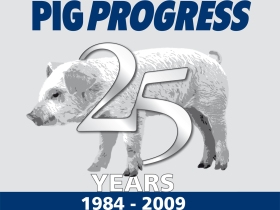Agriculture in 2018

Early this year, I wrote a weblog with the title ‘Agriculture in 2017’. The general idea, quoting several scientific projections, was that the future looked very optimistic for pork production.
Writing that blog, I realised that I had some information that the scientists compiling these projections did not have: there happened to be a global financial crisis by the end of last year and the effects can still be felt everywhere. Hence, I anticipated this blog to be containing slightly less optimistic figures.
I©think I may have been right – albeit for the immediate number of years. All four of them have been updated by now – and enormously optimistic projections for production and pork trade growth have dissolved… until 2011. After that, the pig and pork market is expected to once more grow, supplying food for the increasing world population.
Still, it is good to see what the experts think of the effects of the global crisis – and note that they are certainly positive for the long term.
Financial crisis
The Fapri 2009 US and World Agriculture Outlook, compiled by scientists from Iowa State University and the University of Missouri-Columbia, does mention the crisis’ effects, but anticipates these which will not be long-lasting.
“Recent market turbulence originating in the advanced economies spreads and slows down world economic expansion in 2009 at a rate of -0.7% world gross domestic product (GDP) growth. However, significant recovery is projected the following year, with a long-term real GDP growth rate of 3.5% reached by 2011. After recovery, the emerging markets of China and India still post solid growth, averaging 8.6% and 7.5% per year, respectively.”
Similar key assumptions can be found in the other projections to 2018.
Fapri
Using these assumptions, it is good to note the positive outlooks for pig production on the long term. “Though some decline is expected in 2009, the long-term trend of increasing exports is expected to resume in 2010. The combination of a smaller Canadian hog herd and uncertainty over COOL implementation will result in fewer hogs entering the US from Canada,” the Fapri outlook notes, expecting a maximum contraction of the US sow herd by 250,000, after which numbers grow again until 2015.
USDA
The report USDA Agricultural Projections to 2018©foresees in its outlook slightly declining pig numbers until approximately 2012, after which numbers are growing again. “Pork production declines in 2009-11 in response to high feed prices and then grows for the remainder of the projections as higher hog prices improve returns. Production coordination and market integration between the United States and Canada continue in the hog sector. Canada is the major supplier of live swine imported by the United States.”
FAO-OECD
The OECD-FAO Agricultural Outlook 2009-2018 notes a similar trend of initial contraction and stability, but expects worldwide growth after 2011. The pig meat sector will continue to grow, with projected consumption and production increasing from 102 million tonnes (2009) to 120 million (2018), with an average growth rate of 1.8%.
Prices per kg dead weight are projected to be €1.36 in Europe and US$1.63 in the United States. Total meat consumption goes up to 68.7 kg/year by 2018, from 66.6 kg on average between 2006-2008.
EU DG-Agri
China, Brazil and Russia continue to dominate the pork trade scene, the EU’s DG-Agri Agricultural Commodities Markets Outlook 2009-2018©comments. “The increase in world pork consumption and production over the projection period is again expected to be mainly led by China and other important emerging markets such as Brazil and Russia; however, the sector is supposed to grow, although at a lower pace, also in the EU and in the USA.”
In addition, the financial crisis, the H1N1 outbreak and pork trade developments are conveniently summarised in one paragraph, saying: “In 2009, world pork trade is expected to return to a more habitual level after the record registered 2008. The recovery of Chinese production will probably put an end to the exceptional export opportunities on the world’s largest pork market. Besides, the effect of the economic crisis, the recovery of beef exports, as well as the trade restrictions adopted by some countries to counter the scare linked to the outbreak of the swine flu H1N1, will further hamper the development of trade in 2009.”
Despite projections of Canada’s and EU’s exports to decline, DG-Agri adds: “Nevertheless, world trade of pig meat is likely to expand at a moderate rate (+1.8% per year) between 2009 and 2018. Total exports are thus projected to reach 7.1 million tonnes by 2018, which is a slightly higher level than the record year 2008.”
For an up-to-date easy start to the several projections, click here.











